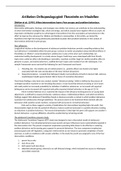Samenvatting
Samenvatting artikelen Orthopedagogiek: Theorieën En Modellen, jaar 2, Universiteit Leiden
- Instelling
- Universiteit Leiden (UL)
Dit artikel bevat een samenvatting van de te leren artikelen voor het tentamen "Orthopedagogiek: Theorieën en Modellen" dat wordt gegeven aan de universiteit Leiden (2e jaar). De artikelen zijn samengevat in de taal waarin ze zijn gepubliceerd, dus een deel zal Engels zijn en een ander deel Nederl...
[Meer zien]




